Noto Shika Korogaki
| Registration Number | 20 |
|---|---|
| Name of the GI | Noto Shika Koro Gaki,NOTO-SHIKA KOROGAKI |
| Class | Processed Foodstuffs |
| Date of Protection | 2016/10/12 |
| Producing Area |
Ishikawa Prefecture
Area of Former Shika-Town (during 1970-2005), Hakui-gun,in Ishikawa Prefecture |
| Applicant - Name and Address | JA-Shika (Japan Agricultural Cooperatives) Shinbo Mukai 1, Sueyoshi, Shika-Machi, Hakui-Gun, Ishikwa Prefecture, 925-0154, JAPAN |
NOTO-SHIKA KOROGAKI is a dried persimmon manufactured by traditional techniques handed down from ancient times using local Saisho persimmons from the Noto region, Ishikawa Prefecture. Compared with persimmons of other localities, it has a vivid light brown color and dense, soft pulp like azuki-bean jelly.
The most important part of the process is to slowly dry the fruit with strict temperature control, which imparts the dense and soft flesh and a light brown color.
First, preprocessing of raw persimmons is carried out, such as removal of the calyx and skin, and they are allowed to dry naturally for about 14~17 days. Environmental conditions in this area such as wind strength, temperature, humidity, and light conditions during the drying stage are considered to be very suitable for the finishing of light brown colored persimmon.
After natural drying is finished, the process moves on to "hand kneading" to sufficiently loosen the flesh. This hand kneading is done thoroughly while cutting the core of the fruit until all the flesh is as soft as an ear lobe. During hand kneading, the moisture in the pulp comes out on the fruit surface, so a heater in the drying room is used to dry them. In this case, the moisture content of the fruit is slowly reduced by carefully adjusting the intensity of the heater. After confirming that the fruit surface does not get wet even after the heating is stopped, it is transferred to a cool, dark room, and stored until just before the sugar comes out as a white powder on the fruit surface.
The climate in this area is mild during the day, but the temperature in the morning and evening is low enough to feel a chill even in summer. This results in growth of raw persimmons with a high sugar content. The average temperature from November on is around 10°C, which is a moderate outside temperature to dry persimmon fruit. In addition, because the production area is located on the coast of the Noto Peninsula, there is a gentle land and sea breeze which can prevent the fruit from molding during the drying phase. For these reasons, this region is suitable for dry persimmon processing.
In this region, many farmers were producing persimmons for their own use as a side job in winter since before the Meiji Period (1868 ~). Thereafter, from around 1932, production for sale started in earnest, and expanded due to the increase in demand for gifts from the rapid economic growth of the 1960s and 1970s. This led to the formation of a large market mainly in the local area, and the Kansai and Kanto regions


